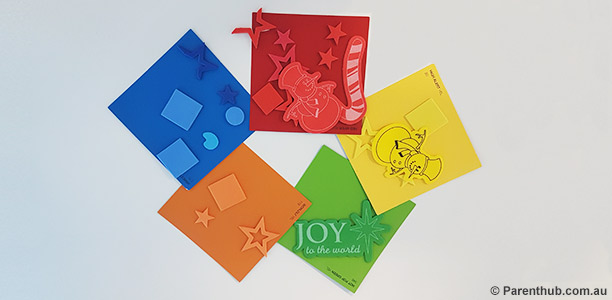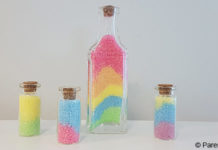Age
18 months to 4 years
Duration of activity
You can fill in a couple of spare minutes playing this game, but your toddler will probably be happy to play for much longer.
Materials/equipment
- Coloured paper or cards
- Coloured stickers that are a single colour (or predominately a single colour) – you can buy coloured stars or dots from most supermarkets, or more elaborate shapes from a $2 shop.
Cost
You can buy coloured stickers at a discount variety store for just a couple of dollars. If you don’t have coloured paper in the house, recycle coloured cardboard packaging or pick up some paint colour cards from your local hardware store.
Preparation
You don’t need to do anything to prepare for this activity.
What to do
 Sit your child where they have a flat surface to work at.
Sit your child where they have a flat surface to work at.- Give them a sheet of coloured paper or card. You can let them choose the colour or choose yourself if you are teaching them to recognise a specific colour.
- Ask them to tell you what colour the paper or card is. Spend a few minutes talking about the colour, for example why they do and don’t like it, what things it reminds them of and what objects in the room are the same colour.
- Explain to your child that they are going to stick stickers on the paper, but they can only stick stickers of the same colour. For example, if your child has a sheet of red paper or card, tell them that they can stick any sticker that is red on it, but if the sticker is not red it should not be stuck on.
- Give your child sheets of different colour stickers. Ask them to point to a sticker that is not red. Then ask them to point to a sticker that is red.
- When they have identified a sticker that is the same colour as their paper, instruct them to peel the sticker from the paper backing and stick it on the coloured paper.
- After they have stuck the sticker on the paper, ask them to describe the sticker, for example to talk about its size (e.g. big or little), describe or name its shape (e.g. round or straight; square or circle) and tell you where it is located in relation to other stickers on the page (e.g. near or far away; above or below).
- Continue sticking stickers until the coloured paper is covered with stickers.
- Ask your child to count the number of stickers on the sheet, pointing to them as they go, and helping them out if they get stuck (which they probably will). But don’t worry if they make mistakes, for example count 1, 2, 5, 8- for young kids just saying the number words is an important part of learning to count.
- If you still have time and your child is happy to keep playing, choose another sheet of paper in a different colour and repeat.
Tips
- Use stickers that are a single colour, rather than those that have several colours in a single sticker.
- Be aware that shapes with fiddly sections like stars, will be harder for children to remove from the paper backing and stick on the coloured paper compared to simple shapes like squares. For younger children squares and circles will be easier to manage. When they get the hang of sticking these, challenge them with more complicated shaped like stars and letters.
Extension activities
- You can make this game more challenging for older children by drawing dots on the coloured paper, and asking your child to stick their stickers over the dots. This extension activity is suitable for children who can already manipulate and stick fiddly stickers independently.
- For children 3-4 years of age, who will be learning how to sort objects based on their colour, you could give them several sheets of coloured paper and get them to sort and stick different coloured stickers as they go. This extension activity is suitable for children who are able to recognise and name different colours.
Educational outcomes
Mathematical skills
Colour
This is a great activity to help young children recognise colours, learn colour names and differentiate between colours. Between 18-36 months your child should develop the ability to recognise objects that go together (e.g. that the red sticker goes with the red paper). Don’t be surprised if your child cannot consistently recognise and sort based on colour until after three years of age, but rest assured that this activity will help them develop their colour recognition skills, no matter what their current age and ability.
 Help them learn by keeping it simple and focusing on a single colour at a time. If you are learning about red, don’t use other colour names, ask your child to tell you if the sticker is red or is not red. It will be easier for them than learning lots of different colour names at the same time- they can learn the names of colours like blue and green another day. Talk about the colour as you play the game, so they your child can associate the colour name with feelings (maybe they like it) and other objects (e.g. maybe it is the same colour as their jumper).
Help them learn by keeping it simple and focusing on a single colour at a time. If you are learning about red, don’t use other colour names, ask your child to tell you if the sticker is red or is not red. It will be easier for them than learning lots of different colour names at the same time- they can learn the names of colours like blue and green another day. Talk about the colour as you play the game, so they your child can associate the colour name with feelings (maybe they like it) and other objects (e.g. maybe it is the same colour as their jumper).
Shapes
Seeing and talking about stickers that have different shapes will also help your child learn to recognise and name shapes. Although they might know shape names like circle, square and triangle, don’t be surprised if they point to a square and tell you it’s a circle. At 18-36 months most children have not yet learnt to recognise shapes consistently- this ability usually develops between 3-4 years of age. But using shape words as they see different shapes is a great way to help them learn.
Vocabulary
This activity provides opportunities for your child to learn new mathematical words, most obviously the names of the colours. Depending on their age they might also learn words to describe the size (e.g. big or little) or quantity (e.g. many or few) of stickers, or their shape (e.g. round or straight). Older children will also be learning words to describe the stickers’ location on the page (e.g. above or under; near or far away).
Counting
Spending a minute or two counting (e.g. the number of stickers) as you complete this activity, will help your child develop other important mathematical skills. Although it is unlikely they will be able to count correctly to ten until about 4 years old, younger children will learn from hearing you count and trying to copy what you say. They’ll be learning even if they count the numbers in the wrong order. In addition to learning to count, they will develop their knowledge of mathematical concepts like one to one matching (i.e. that every object counted represents one), if you point at stickers as you count.
Fine motor skills
Although it’s easy for adults, manipulating stickers is a real challenge for young children who are still developing the small muscles that move their fingers. Using their fingers to peel stickers off the paper backing and stick them flat on a sheet of paper involves finger and hand actions that use many different finger muscles, and help them develop a range of fine motor skills.
For example peeling the stickers off the backing sheet by bending their thumb and forefinger together and inwards toward their palm (known as a flexion movement) will help them develop their pincer grip. Pincer grip is using the tips of the thumb and forefinger to grasp an object. It typically develops by 12 months of age, but continues to strengthen every time a child picks something up using their thumb and forefinger. Your child will also need to move their fingers in the opposite direction, away from their palm, to release the sticker onto the page. This is known as an extension movement.
Any opportunity to pick up and manipulate a small object will help your child develop their finger muscles and fine motor skills. It’s likely that 18-36 month olds will find it difficult to peel the stickers and stick them flat on a page, without for example folding the sticker over and sticking it to itself- but they’ll be developing the skills they need to manipulate stickers and other objects with dexterity, every time they try.
Communication and social skills
Doing activities with your child is also a great way to help them master the art of communicating and socialising effectively. As you work and talk together your child will be learning how to have a conversation, for example when to speak and listen, or ask and answer.
References
- Virginia Early Childhood Development Alignment Program. Milestones of child development- A guide to young children’s learning and development from birth to kindergarten. 2013. (cited 12 March 2017). Available from: (PDF File)
- Jeppson J, Myers-Walls JA. Children and Colours. Purdue University- Human Development Extension. 2003. (cited 12 March 2017). Available from: (PDF File)
- Melbourne College of Professional Therapists. Joint Movements (by joint). 2012. (cited 27 March 2017). Available from: (PDF File)
- Columbia Developmental Progression of the Grasp. UNDATED. (cited 28 March 2017). Available from: (URL Link)



 (4 votes, average: 4.00 out of 5)
(4 votes, average: 4.00 out of 5) 






